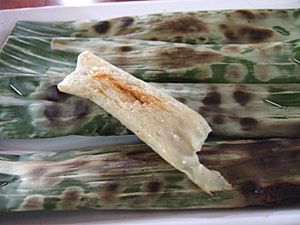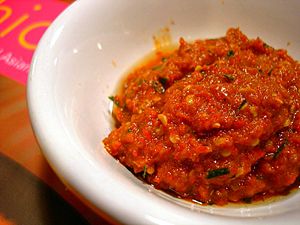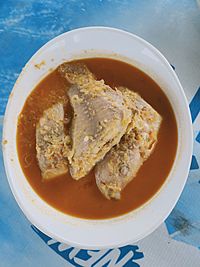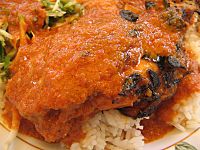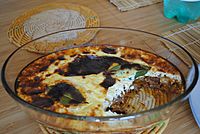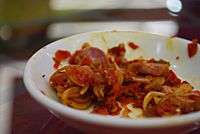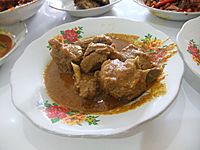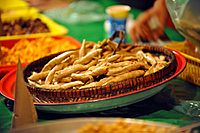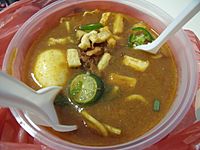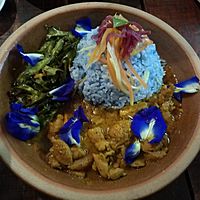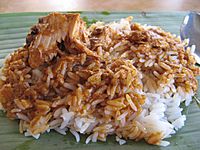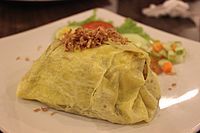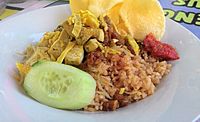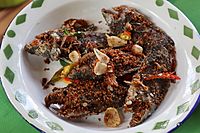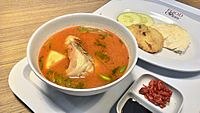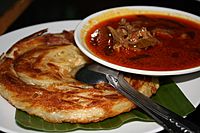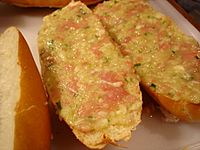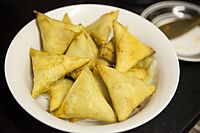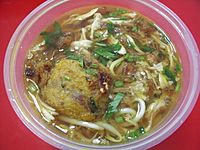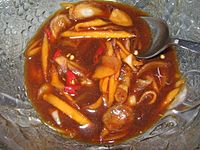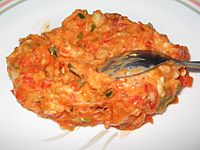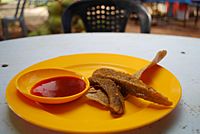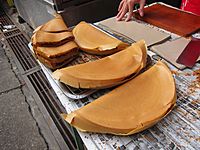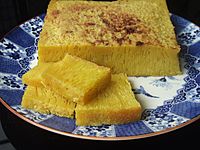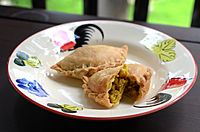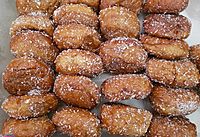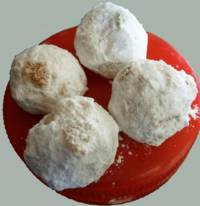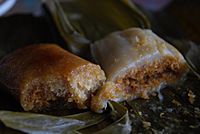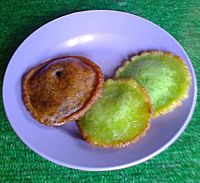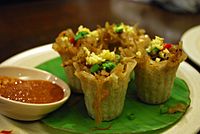Malay cuisine facts for kids
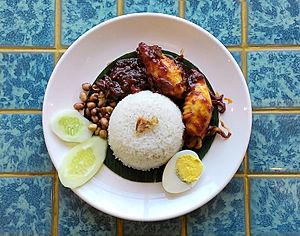
Malay cuisine is the traditional food of the ethnic Malays who live in Southeast Asia. You can find this food in countries like Malaysia, Indonesia (parts of Sumatra and Kalimantan), Singapore, Brunei, Southern Thailand, and the Philippines. It's also enjoyed in places like the Cocos Islands, Christmas Island, Sri Lanka, and South Africa.
Malay cooking uses a lot of spices. Coconut milk is also very important. It makes many Malay dishes rich and creamy. Another key ingredient is belacan (prawn paste). This paste is used to make sambal, a tasty sauce or dip. Sambal is made from belacan, chilli peppers, onions, and garlic. Malay food also often uses lemongrass and galangal.
Almost every Malay meal includes rice. Rice is a main food in many other Asian cultures too. In a Malay meal, all the different dishes are served at once, not one after another. Each person gets a plate of rice. The other dishes are for everyone to share. People usually eat with the fingers of their right hand. They rarely use forks or spoons.
Contents
History and Food Influences
We don't know exactly when Malay cooking traditions started. But we know about them from the 15th century. This was when the Malacca Sultanate became a big trading hub in the Malay archipelago. Malacca was important for the spice trade. It welcomed new ingredients and cooking styles from Arabs, Persians, Chinese, and Indians. This mix led to a rich and varied food culture.
Malacca also helped create two other unique food styles. These are Nyonya and Eurasian food. They mix Malay cooking with Chinese and European traditions. Over time, other groups like the Buginese, Javanese, and Minangkabau people joined Malay society. They shared similar ways of life and religion. These groups also influenced Malay food in different ways.
It's interesting to know what makes a dish "Malay." This depends on whether "Malay" means an ethnic group or a larger "race." In Indonesia, Malay cuisine usually means the food of ethnic Malay people. These people traditionally live on the east coast of Sumatra, the Malay Peninsula, and coastal Borneo. But in Malaysia, Singapore, and Brunei, "Malay cuisine" often means more. It can include food from other nearby Austronesian peoples. This often includes Minangkabaus, Javanese, and Bugis food, or even mixed dishes.
Nasi lemak, which is rice cooked in rich coconut milk, is probably the most famous dish. You can find it everywhere in Malay towns and villages. Nasi lemak is even considered Malaysia's national dish. Another popular food is ketupat or nasi himpit. This is compressed rice cooked in palm leaves. It's especially popular during Hari Raya celebrations.
Many meats and vegetables can be made into gulai or kari. These are types of curry dishes. They have different spice mixes that show Indian influences. Since most Malays are Muslims, Malay food strictly follows halal dietary rules. This means they mostly eat beef, water buffalo, goat, lamb, poultry, and fish. Pork and alcohol are not allowed.
Laksa is a popular dish that mixes Malay and Chinese cooking. Malay cuisine has also taken ideas from nearby food traditions. For example, rendang comes from Minangkabau cuisine in Sumatra. Nasi ulam comes from Betawi cuisine, and satays come from Javanese cuisine in Java. However, Malays have made these dishes their own with unique tastes and recipes.
Malay cuisine has also spread beyond the Malay archipelago. It has influenced other food cultures. Bobotie is a South African dish that started with the Cape Malay people. It's spiced minced meat baked with an egg topping. Bobotie is almost like South Africa's national dish. Its recipe came from the Dutch East India Company colonies in Batavia. The name comes from the Indonesian bobotok. In Sri Lanka, kalu dodol is a dessert with Sri Lankan Malay roots. It's made from kithul jaggery (a type of sugar), rice flour, and coconut milk.
Food Terms and How Food is Made
Every culture has its own words for food. Malay has many terms for how food is prepared, cooked, and for the names of dishes. These terms have been passed down for many generations. Traditionally, Malay parents teach their children how to cook. They do this through daily cooking and during special events like weddings.
Food Preparation Terms

Malay food is known for being spicy and full of flavor. It uses many spices, herbs, and roots. Strong and tasty fresh herbs and spices are often used. These include serai (lemongrass), pandan (screwpine), kemangi (a type of basil), kesum (polygonum), buah pala (nutmeg), kunyit (turmeric), and bunga kantan (wild ginger buds). Also, biji sawi (mustard seeds) and halba (fenugreek) are common.
There are also special words for cooking tools. Traditional tools include grinders like lesung batu (pestle and mortar). There's also batu giling (stone roller) and batu boh (mill). These are used to prepare spices and pastes. Vegetables are cut on a landas (wooden cutting board). A coconut scraper or kukur niyur is a must for making curries and sweets. For pastries, a torak (rolling pin) and papan penorak (pastry board) are very important.
Cooking Methods
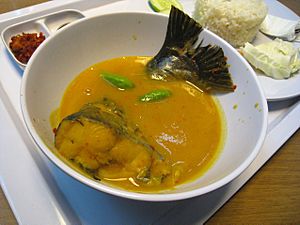
Different cultures have their own unique ways of cooking. Malay cooking methods are often slow and relaxed. This is like life in Malay villages. Most Malay food cooks on low heat for a long time. This is different from Chinese food, which often cooks quickly.
There are many cooking methods, both dry and moist. Tumis means frying with a little oil in a shallow pan over high heat. Salai means smoking or grilling food, often cut into thin pieces. Sangai is frying dried spices without oil. Layur means warming food over low heat to dry it. These are all dry-heat methods.
Moist-heat methods include tanak (cooking in a pot, especially rice). Jerang means boiling or simmering. Celur is blanching or dipping food like vegetables into hot water. Reneh means simmering or boiling food slowly.
Food Characteristics
According to Ainuddin, Malay food has five main features:
- It uses lots of herbs and spices.
- Coconut milk is a key ingredient.
- It is usually spicy.
- Meat is often stewed with a thick sauce.
- Fried fish and seafood are usually seasoned with turmeric powder.
Regional Food Styles
Brunei
Bruneian Malay cuisine is often spicy. It's usually eaten with rice or noodles. Beef rendang, nasi lemak, and pajeri nanas are popular foods in Brunei. One special dish in Brunei is ambuyat. It's a sticky ball of plain sago starch. You wrap it around a bamboo fork and dip it into a spicy and sour sauce.
Nasi katok means "knock rice." It's a popular meal with plain rice, fried chicken, and sambal. Sambal is a spicy relish made from chilli peppers and other things like shrimp paste, garlic, and lime juice. Nasi katok is usually served wrapped in brown paper.
Indonesia
The food of Malay Indonesians is found on the east coast of Sumatra and Kalimantan. Many dishes are shared with Malaysian Malays because they are close relatives. For example, nasi lemak and nasi ulam are traditional dishes in Riau and Jambi. Malay food also shares many similarities with Minangkabau cuisine from West Sumatra. This includes dishes like gulai, asam pedas, kari, lemang, nasi minyak, pempek, pindang, rendang, and roti canai. This is because Minangkabaus are culturally very similar to Malays. Indonesian Malay food has also been influenced by Arab, Betawi, Chinese, Indian, and Javanese cuisine.
Otak-otak is a dish with fish pieces wrapped in banana leaves. This grilled fish cake is made from ground fish mixed with tapioca starch and spices.
Tempoyak is a fermented durian sauce. Sambal belacan is a Malay-style sambal made from fresh chillies and toasted belacan. Both are common sauces in Sumatra.
Other Indonesian Malay dishes include acar, amplang, ayam goreng, ayam pansuh, ayam penyet, ayam percik, begedil, bihun goreng, bobotok, bubur asyura, bubur cha cha, bubur lambuk, bubur pedas, cincalok, epok-epok, various gulai, ikan bakar, various ikan patin dishes, kangkung belacan, kemplang, ketupat, kwetiau goreng, various laksa, lepat, lontong, martabak, mi celor, mi goreng, mi kari, mi rebus, nasi ambeng, nasi briyani, various nasi goreng, nasi kari, nasi kebuli, pekasam, rojak, roti jala, roti john, roti tisu, sambal sotong, samosa, satay, sayur lodeh, various siput gonggong dishes, soto, soto mi, sup ikan, sup kambing, sup rusa, tauhu goreng, tekwan, terang bulan and ulam.
Malaysia
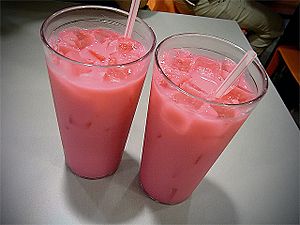
Malaysian Malay cuisine is very similar to Indonesian Malay food. It has also been influenced by Chinese, Indian, Thai, Javanese, and Minangkabau cooking. Many Malay dishes use rempah, which is a spice paste. This paste is usually fried in oil to bring out its flavors. It forms the base of a dish. A dipping sauce called sambal is a must-have with most Malay meals.
Nasi lemak is rice cooked in rich coconut milk. It is considered Malaysia's national dish.
The drink sirap bandung is made of evaporated or condensed milk. It's flavored with rose syrup, which gives it a pink color. This drink is a version of rose milk from India.
Other Malay dishes in Malaysia include apam balik, ayam goreng, ayam masak merah, ayam pansuh, ayam percik, bubur pedas, char kway teow, cincalok, ikan bakar, various kari, karipap, kebebe, kerabu, keropok lekor, kerutuk daging, various laksa, Maggi goreng, masak lemak, mee bandung, mee Jawa, mee kolo, mee siam, mee soto, mee wantan, nasi ambeng, nasi beriani, nasi dagang, Nasi kerabu, nasi goreng, nasi paprik, nasi tumpang, pek nga, roti canai, roti john, satay, taugeh ayam, tempoyak and ulam.
Singapore
Singaporean Malay dishes are influenced by food from nearby Malaysia, Sumatra, Java, and the Riau Islands. Even with these influences, Singaporean Malay food has its own unique taste. It's especially shaped by Minangkabau and Javanese cooking.
Dendeng is thinly sliced dried meat. It's kept fresh with sugar and spices. It's dried by frying. This dish shows Minangkabau influences.
Other Malay Singaporean dishes include assam pedas, bakso, curry puff, gulai daun ubi, Katong laksa, ketupat, lemak siput, mee siam, mee goreng, naan, nasi goreng, nasi lemak, nasi padang, rojak bandung, roti john, sambal stingray, satay, satay bee hoon, soto and sup tulang.
South Africa

Cape Malay cuisine is the food tradition of the Cape Malay people in South Africa. It has been influenced by Malay and Javanese cooking. Cape Malay influence brought spicy curries, sambals, pickled fish, and different fish stews to South Africa. Dishes like bobotie and sosatie are common in many South African homes. Faldela Williams wrote cookbooks that helped keep Cape Malay cooking traditions alive.
Sosatie is a traditional Cape Malay dish. It's meat (usually lamb or mutton) cooked on skewers. The name comes from sate (skewered meat) and saus (spicy sauce). To make it, mutton pieces are marinated overnight in fried onions, chillies, garlic, curry leaves, and tamarind juice. Then they are put on skewers and either pan-fried or grilled.
Cape Malay yellow rice is a sweet dish. It's made with raisins, cinnamon, and sugar. It also started in Cape Malay cooking.
Other Cape Malay dishes include biryani, boeber, chutney, falooda, frikkadel, koesister, roti, sambals, samoosa and tomato bredie.
Sri Lanka
Sri Lankan Malay cuisine has greatly shaped Sri Lankan cuisine. Achcharu is a dish from the local Malay community. Now, it's very popular among all groups in the country. It's a mix of vegetables in a pickled sauce. It tastes sweet, sour, and spicy. Mee goreng and nasi goreng are also popular. These show the influence of Indonesian culture and the country's Malay community.
Other Sri Lankan Malay dishes include different types of curry, ekor sop, kalu dodol, sambals, and watalappam.
Popular Malay Dishes
Main Dishes
- Acar, pickled vegetables or fruits with dried chilli, peanuts, and spices.
- Ambuyat, a starchy dish from the sago palm. It's the national dish of Brunei.
- Amplang, a cracker made from Spanish mackerel, tapioca starch, and other seasonings. It's deep fried.
- Apam johol, a sweet rice cake wrapped in rambai leaves. It's sometimes eaten with rendang or bean porridge.
- Arisa, boiled, cracked wheat mixed with meat and seasoned. It can be like a porridge or a dumpling.
- Asam pedas, a sour stew with fish (usually mackerel), tamarind, chilli, tomatoes, and okra.
- Ayam golek or ayam percik, grilled chicken with a spicy sauce.
- Ayam goreng, a general name for deep-fried chicken. It's usually marinated in spices before cooking.
- Ayam goreng kunyit, deep-fried chicken marinated in turmeric and other spices.
- Ayam masak merah, chicken pieces in a dried chilli sambal. It's a common home-cooked dish with many versions.
- Ayam pansuh, chicken cooked in a bamboo stalk. It's filled with water, seasonings, and covered with tapioca leaves.
- Begedil, round fritters made from mashed potato and sometimes ground meat.
- Bihun belacan, rice vermicelli with a gravy made from ground chillies, belacan, and dried shrimp. It's topped with cured cuttlefish and bean sprouts.
- Bihun goreng, stir-fried rice vermicelli noodles.
- Bihun kari, rice vermicelli mixed with curry. Served with mung bean sprouts and fried tofu.
- Bobotie, a Cape Malay dish. It's spiced minced meat baked with an egg topping.
- Bubur cha cha, a breakfast dish with pearled sago, sweet potatoes, bananas, and coconut milk.
- Bubur lambuk, a savory rice porridge eaten during Ramadhan. It's made with lemongrass, spices, vegetables, and chicken or beef.
- Bubur pedas, a traditional porridge from West Kalimantan. It's made from finely-ground fried rice and grated coconut.
- Cincalok, fermented small shrimp or krill. It's usually served as a dip with chillies and lime juice.
- Dalca, a vegetable curry stew with lentils.
- Dendeng, thinly-sliced dried meat.
- Frikkadel, a Cape Malay dish of meatballs. They are usually baked, but sometimes deep-fried.
- Gulai, a type of soupy curry-like dish. It can be made from meats, fish, or vegetables. This dish comes from Minangkabau.
- Gulai ayam, chicken gulai.
- Gulai kambing, goat or mutton gulai.
- Gulai ketam, crab gulai, a specialty of the Deli Malays of Medan.
- Ikan bakar, grilled or barbecued fish with chilli, kunyit (turmeric), or other spice sauces.
- Ikan mas panggang, barbecued common carp dish, a specialty of Jambi.
- Ikan pari bakar, barbecued stingray dish.
- Ikan patin, a large catfish cooked in different ways like gulai and asam pedas. It's a specialty of Riau and Pahang.
- Kacang pool, a stew of cooked broad beans served with oil and cumin.
- Kangkung belacan, water spinach stir-fried with shrimp paste (belacan) and hot chilli peppers.
- Kari, the Malay version of curry dishes. Like gulai, it can be made from various meats or vegetables. A popular one is kari ayam (chicken curry).
- Kari ayam, chicken curry.
- Kari kambing, goat curry.
- Kari kepala ikan, fish head curry.
- Kebebe, a food made of thirteen ingredients with bitter, salty, sweet, sour, and spicy tastes. It's said to help with indigestion.
- Kemplang, a traditional savory fish cracker from southern Sumatra. It's made of wahoo or Spanish mackerel.
- Kerabu, a type of salad-like dish. It can be made with cooked or uncooked fruits and vegetables, and sometimes meat or seafood.
- Kerutuk daging, a curry made with coconut milk. It's traditionally eaten with white rice and sambal belacan.
- Ketupat, a type of sticky rice dumpling. It's wrapped in a woven palm leaf pouch and boiled. It's usually eaten with rendang or served with satay. Ketupat is also served during Eid al-Fitr.
- Kuning, a rice dish cooked with turmeric, lemongrass, salt, and other spices.
- Kurma, chicken or mutton cooked with spices, nuts, and coconut milk.
- Kuzi ayam, a thick curry. It's traditionally eaten with white rice and sambal belacan.
- Kwetiau goreng, a stir-fried flat rice noodle dish from Indonesia. The Malay version does not have pork.
- Laksa, a spicy noodle soup. It has thick wheat noodles or rice vermicelli with chicken, prawn, or fish. It's served in a spicy soup with coconut milk or sour tamarind.
- Laksa asam, a sour, fish, and tamarind-based soup for laksa.
- Laksa kari, a coconut-based curry soup for laksa.
- Lakso, a noodle dish served in a savory yellowish coconut milk soup. It's flavored with fish and topped with fried shallots.
- Lekor, a specialty from Terengganu. It's a savory cake made from batter and shredded fish. It's sliced and fried, then eaten with hot sauce.
- Lemang, sticky rice and coconut milk cooked in a hollow bamboo stick lined with banana leaves.
- Lepat, a sticky rice dumpling mixed with peanuts. It's cooked with coconut milk and packed in a young coconut leaf.
- Lontong, compressed rice cake shaped like a cylinder. It's wrapped inside a banana leaf.
- Masak lemak, a cooking style that uses a lot of turmeric-seasoned coconut milk.
- Mi bandung, a famous noodle dish cooked with dried shrimp and blended chilli. Often served with a half-boiled egg.
- Mi celor, a noodle soup served in a coconut milk and shrimp-based broth. It's a specialty of Palembang.
- Mi goreng, a spicy stir-fried noodle dish from Indonesia.
- Maggi goreng, a version of mi goreng using Maggi instant noodles.
- Mi jawa, a noodle dish with yellow egg noodles in a sweet potato and tomato sauce with prawn stock.
- Mi kari, thin yellow noodles or rice vermicelli with spicy curry soup, sambal, and coconut milk.
- Mi kolo, light noodles tossed in a clear sauce.
- Mi rebus, a famous noodle dish with noodles served in a tangy, spicy, sweet potato-based sauce.
- Mi siam, a noodle dish of fried rice vermicelli with spicy gravy.
- Mi wantan, thin egg noodles with wonton dumplings.
- Murtabak, a stuffed pancake or pan-fried bread eaten with curry gravy. It's common in Indonesia and Peninsular Malaysia.
- Nasi ambeng, a fragrant rice dish. It has steamed white rice, chicken curry, beef rendang, and other side dishes.
- Nasi Beringin, a fragrant rice dish served to Johor royalty in the late 1890s.
- Nasi briyani, Malay style of flavored rice cooked or served with mutton, chicken, or fish curry.
- Beriani gam, a flavored rice dish usually served with chicken or mutton, a specialty of Johor.
- Nasi berlauk, plain rice served with many different dishes.
- Nasi dagang, the nasi lemak of east coast Peninsular Malaysia. Found mostly in Terengganu and Kelantan.
- Nasi goreng, a fried rice dish with various types.
- Nasi goreng kampung, a common version flavored with pounded fried fish or anchovies.
- Nasi goreng kari, fried rice cooked with curry.
- Nasi goreng masak pedas, spicy fried rice served with chicken or beef.
- Nasi goreng pattaya, chicken fried rice covered or wrapped in a thin fried egg.
- Nasi goreng teri medan, anchovy fried rice. This is a Malay Deli specialty from North Sumatra.
- Nasi kari, curry rice dish from Indonesia.
- Nasi katok, a rice dish with plain rice, fried chicken, and sambal.
- Nasi kerabu, a type of rice that is blue in color (from Clitoria ternatea flowers). It's from Kelantan.
- Nasi lemak, rice steamed with coconut milk.
- Nasi Lemuni, like nasi lemak but cooked with daun lemuni (Vitex trifolia leaves).
- Nasi minyak, rice flavored with dried spices and ghee. It's usually served with rendang.
- Nasi padang, steamed white rice served with many pre-cooked dishes.
- Nasi paprik, a rice dish with lauk (side dishes), usually chicken. It's from southern Thailand.
- Nasi tumpang, rice packed in a cone-shaped banana leaf. It has an omelette, meat floss, and curry. It's from Kelantan.
- Nasi ulam, a steamed rice dish mixed with various herbs and vegetables.
- Otak-otak, a spicy fish cake grilled in a banana leaf wrapper.
- Pekasam, fermented food. In Malay cooking, it's usually freshwater fish fermented with salt and palm sugar.
- Pasembur, a salad of shredded cucumber, boiled potatoes, fried bean curd, and other ingredients.
- Pempek, a savory fishcake from Palembang. It's made of fish and tapioca.
- Perut ikan, a spicy stew with vegetables and herbs. It gets its taste from fish bellies preserved in brine.
- Pindang, fish or eggs cooked in salt and spices.
- Pulut, sticky rice. It's eaten during the Raya holidays as traditional food.
- Rendang, a spicy meat stew from the Minangkabau ethnic group of Indonesia. Malays prepare it during festive times.
- Rojak, a traditional fruit and vegetable salad with Javanese influences.
- Rojak bandung, a rojak dish with boiled water spinach, cucumber, and cuttlefish. It's dressed with a black shrimp paste sauce.
- Roti, a word for all types of bread in Malay and Indonesian. In Cape Malay cooking, it's a round flatbread.
- Roti canai, a thin, flaky bread fried on a skillet. It's served with curry.
- Roti prata, Singaporean Malay fried flatbread.
- Roti jala, a special bread that looks like a fishing net. It's eaten with curry or a sweet sauce called serawa.
- Roti john, a spiced meat omelette sandwich. It's popular for breakfast or as a snack.
- Roti kaya bakar, a traditional breakfast dish. Kaya is a sweet coconut and egg jam spread on toasted bread.
- Roti tissue, a very thin version of roti canai. It's folded into a tall, cone shape. It can be served with curry or as a sweet dessert.
- Samosa or samoosa, Malay-style samosa. It's a fried or baked pastry with a savory filling like spiced potatoes or meat.
- Sata, a traditional dish from Terengganu. It's spiced fish wrapped in banana leaves and grilled.
- Satay, a dish from Java and Sumatra in Indonesia. It's very popular across the Malay Archipelago. Malay chicken satay is like Madura satay with a rich peanut sauce.
- Satay celup, a dish where raw seafood, meats, and vegetables on skewers are dipped into a boiling pot of satay gravy.
- Sayur lodeh, a stew of vegetables cooked in a lightly spiced coconut milk gravy. It has Javanese influences and is popular in southern Malaysia.
- Siput gonggong, a seafood dish made of Laevistrombus canarium. It's a specialty of the Riau Islands.
- Sosatie, a traditional Cape Malay dish of meat (usually lamb or mutton) cooked on skewers. The name comes from sate (skewered meat) and saus (spicy sauce).
- Soto, a noodle soup. The most popular kind is soto ayam, chicken soup with rice vermicelli and ketupat.
- Soto mi, a spicy noodle soup dish with soto gravy.
- Sup ikan, a fish soup specialty of the Riau Islands. It's usually made of red snapper and dried shrimp.
- Sup kambing, a hearty mutton soup. It's slowly cooked with herbs and spices.
- Sup rusa, a soup dish made of venison, carrots, cabbage, and spices.
- Sup tulang, a soup dish made of mutton or beef leg bones stewed in spices. The bones are broken so the marrow can be eaten.
- Tauhu goreng, fried bean curd served with sauces like sambals.
- Taugeh ayam, steamed chicken with bean sprouts and light soy sauce.
- Tekwan, surimi fishcake like pempek, with rice noodles, jicama, and mushroom soup.
- Telur pindang, marbled eggs boiled with herbs and spices.
- Tharid, a lamb stew with pieces of bread in a vegetable and lamb broth.
- Tomato bredie, mutton stew cooked for a long time. It's seasoned with cinnamon, cardamom, and ginger.
- Tumis kangkung, stir-fried water spinach.
- Ulam, a traditional salad of herbs, greens, and vegetables. It's often eaten with a strong dipping sauce like sambal belacan.
Condiments and Sauces
- Balado, a hot and spicy sauce. It's made by stir-frying ground red chilli pepper with garlic, shallot, and tomato.
- Budu, a fermented anchovy sauce.
- Kerisik, a coconut-based condiment. It's made from grated, toasted, and ground coconut. It's used in dishes like kerabu salads and rendang.
- Sambal, a common chilli-based sauce that goes with many foods.
- Sambal belacan, sambal made with chillies, shallots, garlic, and shrimp paste (belacan).
- Sambal gesek, sambal made by pounding fried anchovies, bird's eye chilli, and onions.
- Sambal sotong, squid cooked in a sambal-based sauce.
- Serikaya, a jam made from coconut milk, eggs, and sugar.
- Serunding, spiced meat floss from Javanese cuisine. It can also mean any shredded meat or vegetable dish.
- Tempoyak, a popular Malay condiment made from fermented durian extract. It's commonly eaten with chillies.
Snacks
- Keropok Lekor, a traditional fried fish cracker (keropok) from Terengganu.
- Mee Siput Muar, a deep-fried circular dried noodle snack from Muar, Johor. It's made from flour and eaten with sambal.
Kue and Kuih (Sweets and Cakes)
Kue and kuih (many are called kuih muih) are sweet treats. They are eaten as snacks in the morning or midday. They are also important for celebrations. This tradition is shared by both the Malay and the Peranakan people.
- Agar-agar, a natural vegetarian gelatin. It's used to make puddings and flavored jellies.
- Akok, a traditional sweet dessert from Kelantan, Malaysia. It's made from eggs, coconut milk, flour, and brown sugar. It has a caramel taste.
- Apam balik, terang bulan or martabak manis (in Indonesia), a bread-like puff with sugar, corn, and ground nuts inside.
- Bahulu, a traditional round sponge cake.
- Batik, a chocolate cake similar to a hedgehog slice. It's made using Marie biscuits.
- Bika ambon, a sponge cake from North Sumatra. It's made from tapioca flour, eggs, sugar, yeast, and coconut milk.
- Bingka ubi, a baked kuih made of grated tapioca, coconut milk, and sugar.
- Cara berlauk, a cake made of flour, egg, coconut milk, and turmeric. It has a spiced beef or chicken filling. It's popular during Ramadhan.
- Cincin, a deep-fried dough pastry snack.
- Clorot, a traditional cake with Javanese influences. It's made from gula apong and rice flour, then steamed in palm leaf cones.
- Dadar gulung or ketayap, a pancake filled with coconut. It's often green from pandan leaves.
- Dodol, a sweet, sticky, toffee-like candy. It's made with coconut milk, jaggery, and rice flour.
- Epok epok or karipap, a small pie with curry, chicken, and potatoes in a deep-fried pastry shell.
- Jemput-jemput, a traditional fritter made from flour and fried.
- Kalu dodol, a solid toffee- and jelly-like candy from Sri Lankan Malay cuisine. It's made from coconut milk, rice flour, and jaggery.
- Kochi, a pyramid of sticky rice flour filled with sweet peanut paste.
- Koe'sister, a traditional Cape Malay pastry. It's a spicy dumpling with a cake-like texture, topped with coconut.
- Kaswi, rice cakes made with palm sugar. They are steamed in small cups and topped with grated coconut.
- Keria, sweet potato doughnuts. They are rolled in sugar. They are usually eaten for breakfast or tea in Malaysia.
- Ku, a small, soft, sticky rice flour cake with a sweet filling.
- Lapis sagu or sembilan lapis, a steamed, colorful, layered kuih. It's made from tapioca flour, coconut milk, and pandan.
- Lapis sarawak, a layered cake served in Sarawak on special occasions. It comes from the Indonesian lapis legit.
- Makmur, a traditional cake made from butter, ghee, and flour. It's served during Eid al-Fitr.
- Pai ti, a thin and crispy pastry shell filled with a spicy, sweet mix of vegetables and prawns.
- Pinjaram, a saucer-shaped deep-fried fritter with crisp edges.
- Pisang goreng, battered fried bananas.
- Pulut inti, sticky rice topped with caramelized grated coconut. It's wrapped in a banana leaf.
- Pulut tartal, sticky rice served with white coconut milk sauce.
- Pulut tekan, a sticky rice cake. It's served with kaya (coconut jam). The rice cakes are colored blue with bunga telang flowers.
- Seri muka, a two-layered dessert. The bottom is steamed sticky rice, and the top is a green custard layer made with pandan juice.
- Talam (meaning "tray cake"), a kuih with two layers. The top white layer is rice flour and coconut milk. The bottom green layer is green pea flour and pandan leaf extract.
- Wajik, a compressed candy made of sticky rice cooked with coconut milk and palm sugar.
Drinks
- Air janda pulang, a traditional drink from Negeri Sembilan. It's good to drink with lunch or on hot days.
- Ais kacang, a dessert drink made of shaved ice and red beans.
- Ais krim potong, a popsicle made from coconut milk or milk. It's flavored with things like red beans, rose syrup, and durian.
- Boeber, a Cape Malay sweet milk drink. It's made with vermicelli, sago, sugar, and flavored with cardamom and rose water.
- Cendol, an iced dessert. It has green rice flour jelly, coconut milk, and palm sugar syrup.
- Dadiah, a dairy dessert made from milk, sugar, and salt. It's fermented and steamed to be like a custard. It shows influences from Minangkabau cuisine.
- Faluda, a cold drink made by mixing rose syrup, vermicelli, and sweet basil seeds with milk. It's often served with ice cream.
- Kopi tarik, a coffee drink made of dark roasted coffee with margarine and sugar. It's sweetened with condensed milk and frothed.
- Laksamana mengamuk, a traditional drink from Riau. It's made from mango mixed with coconut milk and sugar.
- Milo dinosaur, a drink made of iced Milo with undissolved Milo powder on top.
- Sirap bandung, a drink made of evaporated or condensed milk flavored with rose syrup. It's pink and is a version of rose milk from India.
- Teh krisan, a Chrysanthemum tea.
- Teh tarik, a popular hot milk tea drink. It's found in Indonesia, Malaysia, and Singapore. It's made from strong black tea mixed with condensed milk.



